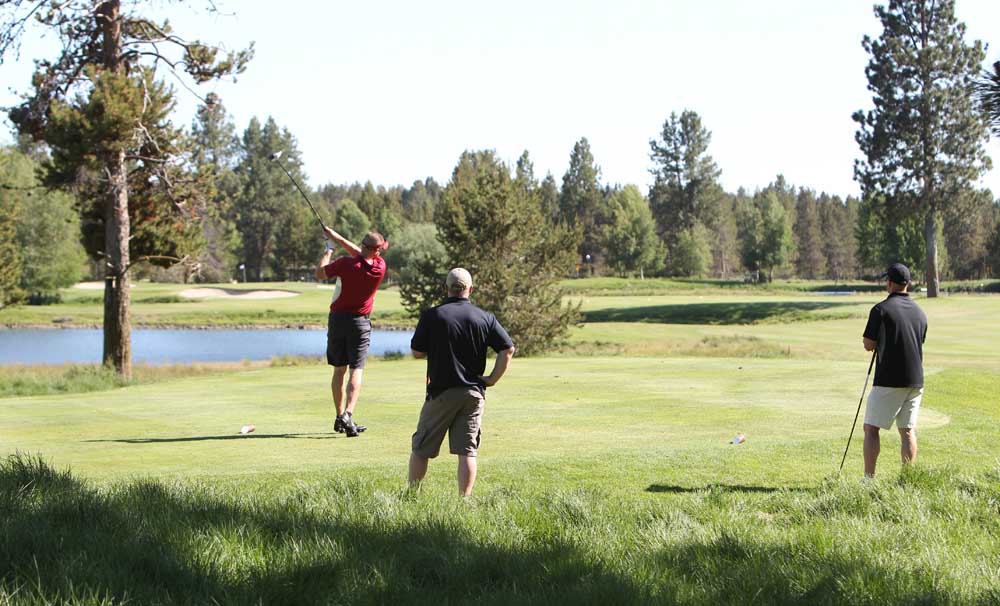Sunriver Woodlands
Published 12:00 am Monday, June 16, 2014

- Sam Grant of Pasco, Wash., tees off on No. 9 while playing Tuesday.
SUNRIVER —
It did not take long for me to realize the difference the new greens have made at Sunriver Resort’s Woodlands course.
I played Woodlands on a recent quiet weekday morning, and after struggling to reach the green on the 550-yard first hole — the first in the course’s set of enticing par 5s — I needed to make a 10-foot putt to salvage bogey.
Short of the hole on the uniformly green putting surface, I knew I could trust my line. After all, the first hole is one of five greens that were replaced this spring, the final phase of a project that started in 2010 to replace all 18 Woodlands greens with a hardy strain of bentgrass.
With a firm putting stroke, I sent the ball rolling perfectly toward the hole and it dropped in.
The greens held true, a testament to the work by the Sunriver Resort maintenance staff.
“It’s been a long, hard process,” said Ryan Wulff, Sunriver Resort’s superintendent. “It’s been a lot of work and we’ve had a lot of support from (management at Sunriver Resort). I am just glad that everybody sees the benefit that we are going to get out of these new bentgrass greens.”
Wulff is not exaggerating about the work his staff put in to replace the greens. Instead of buying turf from an outside company — something Sunriver did three years ago when it replaced all 18 greens at Crosswater Club — Sunriver grew the turf itself using its own nursery.
That takes time.
The project was originally slated to take nine years. But Woodlands has replaced several greens each year since 2010, and this spring, greens on the first four holes and on the par-4 18th were replaced to complete the project four years earlier than planned.
“It has been a huge challenge,” Wulff said. “All of the guys that have been involved with it … have put 100 percent into it. It’s definitely WAY more challenging and there is a lot more to it than anybody understands. It’s been a learning process for us, too.”
The result is a golf course with universally smooth putting surfaces that beg a golfer to take a fresh look at the 33-year-old position golf course. (The new greens are, as expected, still a touch slow as they take firm root.)
Among the first golf courses in Central Oregon to be designed by a big-name architect — in this case Robert Trent Jones Jr. — Woodlands has always been an enjoyable place to play.
Doglegs are present on 12 holes, making your choice of routes to the green of paramount importance, a hallmark of Jones’ courses.
The ponderosa pine-lined course challenges golfers to think their way around it, sometimes forcing awkward shots around trees and bunkers.
An extreme example is the 416-yard, par-4 ninth hole, which doglegs around a large pond.
The hole offers two choices, and neither is easy. One, you can cut off significant yardage by hitting driver over the water to a thin landing area (the target is a sliver of fairway with water both short and long), leaving an easy pitch to the green.
Struggling with control off the tee, I played it safe and opted for a 220-yard shot to the right. The problem was that left a difficult iron shot into the green — a shot that must be played around a massive ponderosa guarding the direct line to the hole.
My decision turned out to be a mistake. Left with a 7-iron to the hole, I mis-hit my approach shot into the ponderosa, and my ball dropped to the base of the tree. With no chance from there at a full swing, I had to chip clear of the ponderosa, inching my ball toward the hole before finally hitting a wedge into the green.
On in four shots, I easily two-putted for double bogey. So much for playing it safe.
The ninth hole is the most extreme example of the risk-reward choices Woodlands forces a golfer to make. A gambler by nature, I have always enjoyed this style of golf.
On this day, though, I was burned more often than not by my choices.
At least the greens at Woodlands are true, even if my golf swing is not.
Difficulty of course
The Woodlands is not overly taxing for golfers who play under relative control. But the position course can be punitive for those who struggle to hit their target, particularly those who are wild off the tee.
As the course’s name suggests, Woodlands is characterized by ponderosa pines. However, the trees that line course are most often set far enough from the fairway to keep the ball in play after a moderate miss. A dicey secondary rough, though, puts an additional premium on accuracy.
Novices will not have to worry about a forced carry over water, but Woodlands has a significant number of water hazards that can be tricky to navigate around for lesser-skilled golfers.
Favorite hole
The par-5 15th sets up a wonderful series of finishing holes — as it has since 2010, when the original front and back nines were flipped. A 530-yard dogleg left, 15 entices longer hitters to take a shortcut over the roomy bunker guarding the left side of the fairway about 250 yards from the back tees.
Those who make the shortcut should have a clear downhill shot to the green for an opportunity at an eagle. But the risks are plentiful. The fairway bunker is tough to escape, and drives that drift even slightly right from the intended target just right of that bunker could run through the fairway and into a pine-lined prison.
The second shot should be played to the left side of the fairway. That will help take the waste bunker and a pine that is set about 70 yards short of the green’s right side out of play for the approach shot into the flat green.
How to approach the course
If you are playing the set of tees that best suits your game, the fairway bunkers should help you guide your tee shot to the proper position.
However, playing conservatively off the tee is often a wise choice to avoid the thick rough and the numerous pines. If you find the heavy rough, best not to overplay your hand by taking a risky shot. In most circumstances, it is best to work the ball back into the fairway for a clearer shot.
Longer irons into the greens, though, can be a challenge. The greens are typically heavily bunkered and are most often set at a different elevation from the fairway, forcing a downhill or uphill approach shot. In some cases, playing an aggressive tee shot over the fairway bunkers can shorten a hole considerably and lead to a short-iron approach.
The greens offer mostly subtle breaks, but a true line is rewarded by the new bentgrass greens.
Off the course
The Woodlands’ facilities are separate from Sunriver Resort’s three other golf courses. Its pro shop is exclusively dedicated to Nike products, and the nearby snack bar serves all the basics, including hamburgers, sandwiches, soda and beer.
A sizable putting greens sits next to the clubhouse, and the Woodlands’ modest driving range still has enough room on all but the busiest days. Woodlands does have a significant short-game practice area between the driving range and the 18th green.
Verdict
With its greens now all bentgrass, the Woodlands is an excellent golf course (and the best designed of Sunriver Resort’s two daily-fee courses) that will put a premium on accuracy. The green fees at Sunriver Resort have ticked up in recent years, and this season they will peak after July 3 at $119 for Deschutes County residents. That is a bit high, even though the fee includes the use of a cart. However, the Deschutes County rates drops significantly as the day goes on, and $59 including cart after 2 p.m. during weekdays is a decent value for the quality of golf course.
— Reporter: 541-617-7868, zhall@bendbulletin.com.
Editor’s note: This is another installment in a seasonlong series in which Bulletin golf writer Zack Hall visits each public and semiprivate golf course in Central Oregon.






